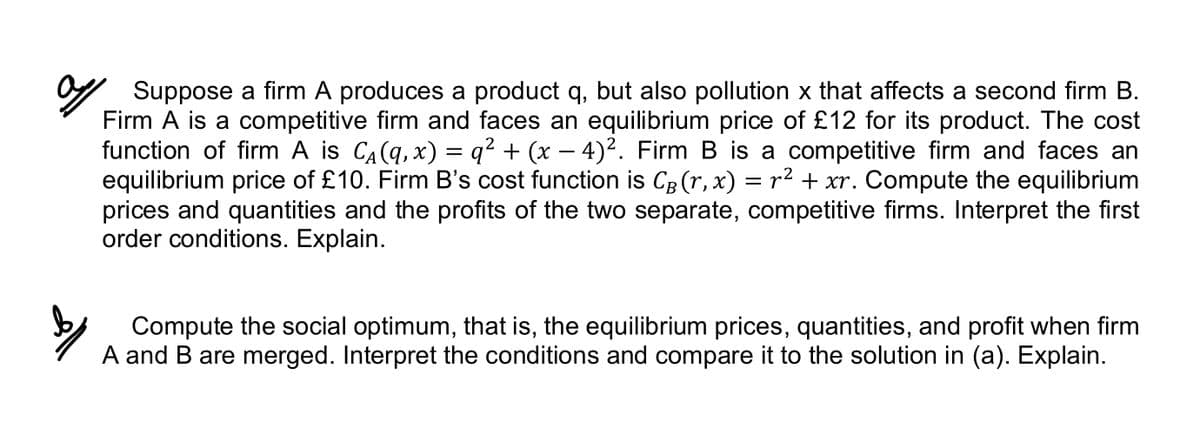Suppose a firm A produces a product q, but also pollution x that affects a second firm B. Firm A is a competitive firm and faces an equilibrium price of £12 for its product. The cost function of firm A is CA (q, x) = q² + (x-4)². Firm B is a competitive firm and faces an equilibrium price of £10. Firm B's cost function is CB (r, x) = r² + xr. Compute the equilibrium prices and quantities and the profits of the two separate, competitive firms. Interpret the first order conditions. Explain. Compute the social optimum, that is, the equilibrium prices, quantities, and profit when firm A and B are merged. Interpret the compare it to the solution in (a). Explain.
Suppose a firm A produces a product q, but also pollution x that affects a second firm B. Firm A is a competitive firm and faces an equilibrium price of £12 for its product. The cost function of firm A is CA (q, x) = q² + (x-4)². Firm B is a competitive firm and faces an equilibrium price of £10. Firm B's cost function is CB (r, x) = r² + xr. Compute the equilibrium prices and quantities and the profits of the two separate, competitive firms. Interpret the first order conditions. Explain. Compute the social optimum, that is, the equilibrium prices, quantities, and profit when firm A and B are merged. Interpret the compare it to the solution in (a). Explain.
Managerial Economics: A Problem Solving Approach
5th Edition
ISBN:9781337106665
Author:Luke M. Froeb, Brian T. McCann, Michael R. Ward, Mike Shor
Publisher:Luke M. Froeb, Brian T. McCann, Michael R. Ward, Mike Shor
Chapter10: Strategy: The Quest To Keep Profit From Eroding
Section: Chapter Questions
Problem 10MC
Related questions
Question
Please answer with very clear solutions with clear steps and explainantion. Please do not answer if you are not confident.

Transcribed Image Text:Suppose a firm A produces a product q, but also pollution x that affects a second firm B.
Firm A is a competitive firm and faces an equilibrium price of £12 for its product. The cost
function of firm A is С₁(q, x) = q² + (x − 4)². Firm B is a competitive firm and faces an
equilibrium price of £10. Firm B's cost function is CB (r, x) = r² + xr. Compute the equilibrium
prices and quantities and the profits of the two separate, competitive firms. Interpret the first
order conditions. Explain.
Compute the social optimum, that is, the equilibrium prices, quantities, and profit when firm
A and B are merged. Interpret the conditions and compare it to the solution in (a). Explain.
Expert Solution
This question has been solved!
Explore an expertly crafted, step-by-step solution for a thorough understanding of key concepts.
Step by step
Solved in 4 steps

Knowledge Booster
Learn more about
Need a deep-dive on the concept behind this application? Look no further. Learn more about this topic, economics and related others by exploring similar questions and additional content below.Recommended textbooks for you

Managerial Economics: A Problem Solving Approach
Economics
ISBN:
9781337106665
Author:
Luke M. Froeb, Brian T. McCann, Michael R. Ward, Mike Shor
Publisher:
Cengage Learning

Managerial Economics: A Problem Solving Approach
Economics
ISBN:
9781337106665
Author:
Luke M. Froeb, Brian T. McCann, Michael R. Ward, Mike Shor
Publisher:
Cengage Learning